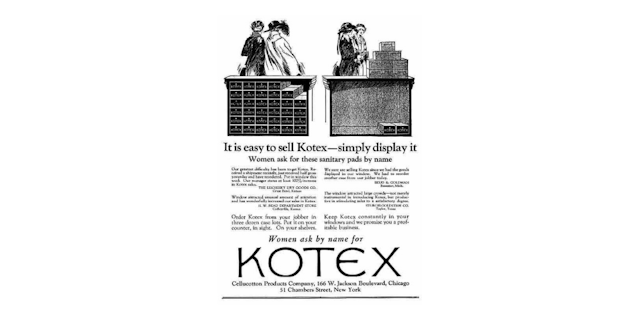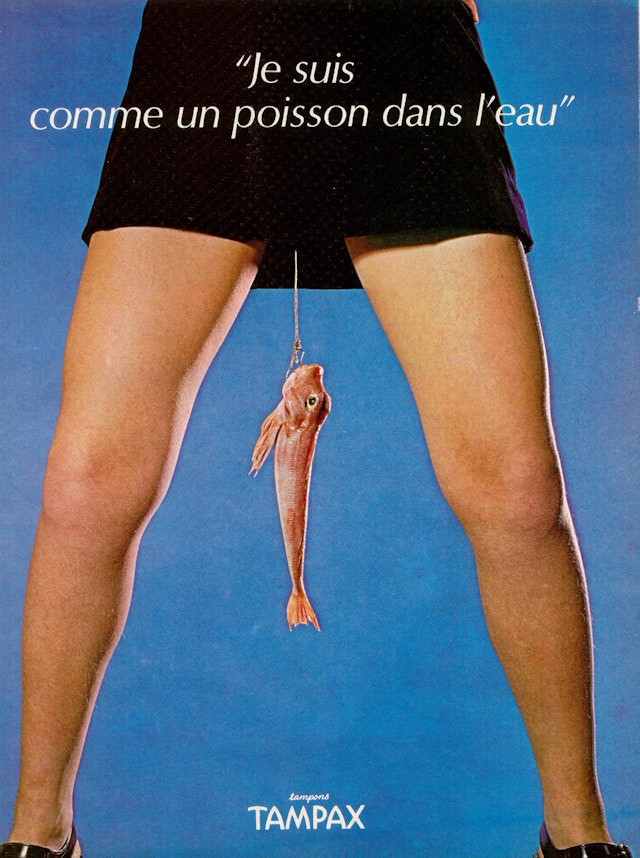From ‘gory’ to glory, the evolution of period advertising
It’s baffling, to say the least, that in 2020 period brands still face backlash for ’daring’ to open up the conversation surrounding menstruation. The Drum looks at the evolution of period advertising throughout the years, to see how far we’ve really come.

Bodyform’s 'Womb Stories' ad, one of several attempts to shift the narrative on the menstrual taboo.
It’s fair to say we’ve come a long way when it comes to advertising menstruation products. Period.
It’s the most natural thing in the world and affects half the population, so what is it about the menstrual cycle that still causes people to recoil with shock if a brand ’dares’ to mention the word ’vagina’?
Just the other day, Facebook found itself in hot water after it banned a Modibodi ad for depicting blood, leaving people gobsmacked that periods can still be a taboo subject in 2020.
Hush-hush

While at first glances this might look like a vintage ad for lingerie, when the first advertisements for menstrual products began to appear in the 1870s, most advertised reusable menstrual pads, held in place by suspenders. Of course, no mention of their literal function made it to print.
For years, period ads have focused on the fact that people should be discreet about their flow like it’s something to be ashamed of.

TV milestone
Despite the fact the television and sanitary napkins are around the same age, it took until 1972 for the latter to be advertised on the former.
Frustrated by the inability to market their products, a number of brands including Tassaway and Scott Confidets worked to break the ban set by the National Association of Broadcasters (NAB). Pressured, the NAB finally lifted the ban and Scott Confidets was the first menstrual hygiene product to advertise on TV.
Despite getting the green light, brands were restricted from what they could say on air and could not make any reference to absorbency, cleanliness, anatomy, comfort, insertion, application, duration or efficacy leaving them with just generalised statements.
‘Period’
While the TV ban was lifted in 1972, it wasn‘t until 1985 that the word ‘period‘ was used, by non-other than a pre-Friends Courtney Cox. An advert for Tampax saw Cox looking overtly 80s in tight spandex, telling the audience, “feeling cleaner is more comfortable. It can actually change the way you feel about your period.”
Nothing changes
20 years after Cox’s breakthrough ad, you’d imagine that advertising would have advanced beyond teaching young girls to be secretive about their periods. Alas, a 2005 Tampax ad focused on two pupils caught passing a tampon in class. However, rather than the girl proudly letting the class know about her flow, the discreet packaging fools the teacher and the girls get away with their secret transaction.
Kotex gets real
“Mamma can I talk to you about my period,“ asks a young girl as she walks along the beach hand in hand with her mother. “Of course,“ her mother responds. “But since this is a TV commercial, I’ll have to use confusing metaphors. If I want to explain where a tampon goes, I can’t say the word that rhymes with the serious medical condition, angina.“
Poking fun at the fact that ads for menstrual products have historically been conspicuously euphemistic, ’Just Get Real’ rebelled against it.
But this wasn’t the original version of the ad. Created by JWT, the original was deemed too ’frank’ for using the word ’vagina’, and so got banned by the major US television networks. Even this updated version that substituted ’down under’ for ’vagina’ got dropped by two networks, and so they dropped the idea all together.
I wonder where that fish has gone

The literal translation for this French tampon ad: ’I am a like a fish in water.’
Like a girl
Always’ groundbreaking 2014 ’#LikeAGirl’ spot has been widely celebrated for breaking stereotypes and empowering women. To make people contemplate why the phrase ’like a girl’ has become an insult, the ad asked men and women to do things...well, like a girl.
Flipping their hair and flailing their arms around when asked to run, throw and fight like a girl, the men and women in the spot dutifully illustrated the harmful stereotype. However, when they asked young girls to do the same, the results were drastically different.
Thinx causes a stink

Makers of ’period-proof underwear’ Thinx made headlines in 2015 when Outfront Media, the firm that manages advertising within the New York City subway system, considered not running it’s out-of-home ads because they used the word ’period’ and included ’suggestive’ imagery, such as grapefruit and runny eggs to allude to the female anatomy.
Thinx’s ads were eventually approved and went up in three subway stations throughout New York City, including bustling Grand Central and Williamsburg’s Bedford Avenue stop.
Blood Normal
The first in the UK to depict real period blood, Bodyform’s ’Blood Normal’ sent well-needed shock waves in 2017. Up until that point, references to period blood were only permissible as a watery, blue, Windex-type liquid used solely to illustrate the absorption of period pads. Which is why this ad was so groundbreaking.
People who menstruate
In 2017, period subscription service Pink Parcel placed transgender model Kenny Jones at the front of its awareness campaign.

Thinx string
Last year, Thinx found itself at the receiving end of an ad ban once again when numerous networks rejected its first TV ad for showing a tampon string hanging out of someone's underwear.
The spot imagines a world where everyone has periods – including men – to hilarious effect. Thinx, which briefed BBDO New York to create the ad, originally attemped to get the commercial signed off with a scene depicting period blood staining a bedsheet, too. However, it soon discovered why so many female hygiene brands are forced to use such blue liquid.
#TheWholeBloodyTruth
With JK Rowling’s infamous tweet bringing the debate over menstruation into public discourse, period brands have been entering the discussion by making their sanitary products more inclusive for people who bleed.
Following the author’s debacle, the organic brand Callaly urged the industry to change the narrative, aiming to provide ’the whole bloody truth’ on periods.
Womb Stories
Once again Bodyform shifted the period paradigm with ’Womb Stories’, a beautifully shot ad that explored the duality of the uterus and showed menstruation for what it is: messy, painful and a sometimes welcome relief.
Its most ambitious ad to date, it covered IVF treatment, endometriosis cramps, menopausal hot flushes, nipple hairs and first periods, giving a voice to the unseen, unspoken and unknown truths about the physical experiences of women everywhere.
Tampax and tea
In August, the Advertising Standards Authority Ireland (ASAI) had to step in after a Tampax ad received 84 complaints from critics claiming the ad caused ’general offence’ and that it was ’demeaning to women’.
While the complaints have been branded ’ridiculous,’ the ASAI told Tampax it must not run in the ad in same format because it caused offence. The decision to ban the ad has been widely criticised for making a taboo of women's bodily functions.
Pantone

Dividing opinion, the Pantone Colour Institute recently introduced a new colour. In a bid to smash taboos and get people talking about menstruation, the colour maker and the Swedish feminine products brand Intimina created a ‘Period‘ red, which is described as an “original shade of red that represents a steady flow.“
Facebook period ban
It feels like Facebook is always in the news for arguments over what is, and what isn’t, acceptable on its platform. Earlier this month it found itself in the middle of a Twitter storm over its decision to ban a Modibodi period underwear ad because the period blood shown violated its guidelines – a move it has since retracted.
According to Australian brand Modibodi, which creates period-proof underwear, Facebook claimed the spot violated its guidelines, which block ”shocking, sensational, disrespectful or excessively violent content.” Facebook has since backtracked on its decision to censor the ads, following a review.
Check out The Drum’s special Health hub, which examines how the key players – from health agencies to pharma firms to brands – are doing their part to return the world to normality.

